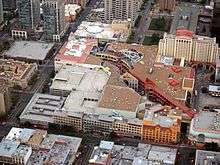Westfield Horton Plaza
 Horton Plaza | |
| Location | San Diego, California, USA |
|---|---|
| Address | 324 Horton Plaza, San Diego, CA 92101-5481 |
| Opening date | August 9, 1985 |
| Developer | The Hahn Company |
| Management | Westfield Corporation |
| Owner | Westfield Corporation |
| No. of stores and services | 130[1] |
| No. of anchor tenants | 3[1] |
| Total retail floor area | 758,003 sq ft (70,420.8 m2)[1] |
| No. of floors | 5 |
| Parking | 2,189[1] |
| Public transit access | Civic Center station |
| Website | Official website |
Westfield Horton Plaza, not to be confused with its adjacent namesake Horton Plaza, is a five-level outdoor shopping mall located in downtown San Diego known for its bright colors, architectural tricks, and odd spatial rhythms. It stands on 6.5 city blocks adjacent to the city's historic Gaslamp Quarter. It was the first successful downtown retail center since the rise of suburban shopping centers decades earlier.[2]
History
1970s
A 1972 proposal for the shopping center and a redevelopment district arose out of plans to "refurbish San Diego's historic town plaza", Horton Plaza. Due to numerous setbacks and resistance from preservation groups, construction did not begin until 1982.[3] The plaza is named for Alonzo Horton, who was largely responsible for the location of downtown San Diego.
1980s - 1990s


Horton Plaza was the $140 million centerpiece of a downtown redevelopment project run by The Hahn Company, and is the first example of architect Jon Jerde's so-called "experience architecture". When it opened in August 1985, it was a risky and radical departure from the standard paradigm of mall design. Its mismatched levels, long one-way ramps, sudden dropoffs, dramatic parapets, shadowy colonnades, cul-de-sacs, and brightly painted facades create an architectural experience in dramatic contrast to the conventional wisdom of mall management. Conventional malls are designed to reduce ambient sources of psychological arousal, so the customers' attention is directed towards merchandise. By making the mall an attraction in itself, Jerde stood this model on its head.
Jerde's project was based on Ray Bradbury's essay "The Aesthetics of Lostness".[4] In it he extolled the virtues of getting "safely lost" as adults inspired by side streets of Paris, London, or New York.[5]
Horton Plaza was an instant financial success and while some credited it for revitalizing downtown San Diego, others said the revitalization benefitted the mall.[2]
When originally built, the center housed the historic Jessop's Clock, built in 1907, which formerly stood on a sidewalk in front of the Jessop and Sons jewelry store in Downtown San Diego.[6]
In 1998 the owners of the mall sold it to the Westfield Group, now the Westfield Corporation.[7]
2010s - Now
On January 11, 2011, the San Diego City Council unanimously approved a plan to raze the former Robinsons-May building on the north side of the mall to make way for a 37,000 square feet (3,400 m2) urban park, effectively enlarging the adjacent, historic Horton Plaza and Broadway Fountain.[8] Westfield partnered with the city to renovate and restore the area into an urban park and public gathering place called Horton Plaza Park. Westfield agreed to operate the park and schedule events, which could include concerts, movie screenings, and celebrations. Horton Plaza Park will have a 53,000 square foot venue, a Cabrill hitheater, an interactive pop-jet fountain and 23 foot tall color-changing statues.[9] The new Horton Plaza Park had its grand opening on May 4, 2016.[10]
In 2012 Westfield said it would not renew the lease on the Jessop's Clock and gave its owners (descendants of the clock's builder Joseph Jessop) six months to find a new location for it.[11] However, the heirs had trouble finding an appropriate location, and as of 2016 the clock is still at Westfield Horton Plaza.
May 4, 2016 Horton Plaza Park Opens after 5 years in the making.
June 24, 2016 Nordstrom announces closing of Horton Plaza store on August 26, 2016, Leaving one anchor (Macy's) left in the mall.
http://www.nbcsandiego.com/news/local/Horton-Plaza-Nordstrom-Announces-Store-Closure-384291441.html
References
- 1 2 3 4 "Westfield Horton Plaza". Westfield Group. Retrieved 2011-02-09.
- 1 2 Crawford, Richard (1995). "Horton Plaza Redevelopment Project". The Journal of San Diego History. San Diego Historical Society. 41 (3).
- ↑ Eddy, Lucinda (Summer 1995). "Visions of Paradise: The Selling of San Diego". The Journal of San Diego History. 40 (3). Retrieved 4 October 2012.
- ↑ Bradbury, Ray (2015-01-29). "The Pomegranate Architect". Paris Review Daily. Retrieved 2016-03-26.
- ↑ Sam Weller, Ray Bradbury Chronicles, p. 292
- ↑ Jessop, Joseph E. (Winter 1987). "The Jessop Street Clock: A San Diego landmark". Journal of San Diego History.
- ↑ Staff, Los Angeles Times. April 07, 1998 TrizecHahn to Sell 20 Shopping Centers to REITs: Horton Plaza, Fox Hills Are Included in Deal
- ↑ "Horton Plaza Park Approved By City Council" January 11, 2011.
- ↑ "The History & Future of Horton Plaza in Downtown San Diego". Buy Sell Rent San Diego. 2016-04-01. Retrieved 2016-05-04.
- ↑ "4 May Grand Opening for Horton Plaza Park". Fox 5 San Diego. May 4, 2016. Retrieved 4 May 2016.
- ↑ Bell, Diane (June 27, 2012). "Historic Jessop's clock must find a new home". San Diego Union Tribune. Retrieved 20 February 2014.
External links
| Wikimedia Commons has media related to Westfield Horton Plaza. |
- Official website
- an evolution of the shopping mall urban form, with pictures of Horton Plaza
- Information on Horton Neighborhood
- Remarks of Senator John F. Kennedy, Horton Plaza, San Diego, CA
Coordinates: 32°42′49″N 117°9′45″W / 32.71361°N 117.16250°W